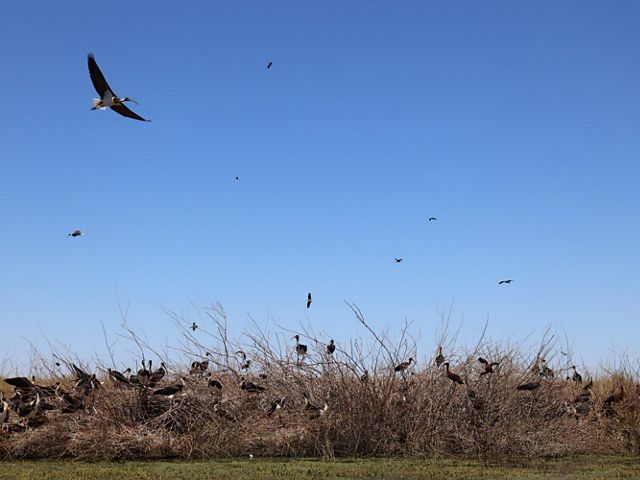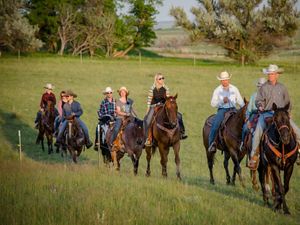5 Environmental Good News Stories
We could all use a little conservation good news! These stories from around the world show how our conservation work thrives.
If you’ve scrolled through environmental news recently, there’s a good chance you saw a lot of negative headlines. Rightfully, these stories inform us about the urgent issues that affect us all.
With our tendency to focus on the bad, it can be easy to miss the good news. Environmental success stories are happening all around the world, and they’re worth reading (and sharing) too!
Many of the conservation projects The Nature Conservancy (TNC) and our partners work on are vast in scale and take considerable time to accomplish. Though the pandemic has forced us to adapt our work, thousands of our staff in over 70 countries and territories continued the important task of protecting land, freshwater, and oceans, slowing biodiversity loss, and fighting climate change.

Some of these successes have been decades in the making—and we’re so excited to share them with you!
Our favorite conservation good news stories
1. We protected 236,000 acres of the Selva Maya tropical forest in Belize
The Selva Maya is part of the Mesoamerican ecosystem, which is now the largest contiguous block of rainforest north of the Amazon and a biodiversity hotspot threatened by increased logging and agriculture. With the help of partners, TNC purchased 236,000 acres (96,000 hectares) next to the Rio Bravo Conservation Management Area.
The combined protected area is a tenth of Belize's total land area and provides uninterrupted habitat for hundreds of rare and valuable species, such as jaguars.
But that's not all this area provides: people also benefit from protecting the Selva Maya.
- The forest provides services such as clean air and water security, worth billions of dollars every year.
- The intact forest is a living carbon reserve, a natural and cost-effective solution for climate change.
- Rainforest tourism earns Belize US$15 million every year. In fact, tourism accounts for 40% of their GDP!
- Farms near the forest rely on pollinators that live in the protected areas.
Selva Maya Stats
-
236,000
acres protected (1/10 of Belize's total land area)
-
400
bird species live here, thousands more travel here
-
$15 M
in rainforest tourism every year (USD)
-
25%
of farms benefit from pollinators in protected areas
2. We helped return Gayini to the Nari Nari people in Australia
In late 2019, we were proud to facilitate the transfer of legal ownership of Gayini back to the Nari Nari people, the traditional custodians of the land. Gayini (which means "water" in the Nari Nari language) is one of the largest remaining wetlands in New South Wales and has international conservation value. The wetlands are important habitat for many birds, fish and amphibians. Seeing tens of thousands of straw-necked ibis and royal spoonbills gather in Gayini to feed and breed is a special sight.

The Nari Nari people manage the 216,998 acre (87,816 hectare) property for endangered wildlife conservation, sustainable agriculture, and to protect their cultural heritage. They are implementing a culturally appropriate management model that balances conservation with other land uses. This includes returning the land to a more natural flooding regime, removing invasive species, and implementing responsible, low-impact grazing. Soon, they hope to have new sustainable land use opportunities, such as carbon farming, educational centers, and ecotourism.
The management style is already showing results. The critically endangered plains-wanderer, one of Australia's rarest birds, and one of the largest ibis breeding events were recorded in Gayini recently.
Gayini Stats
-
216,998
acres protected
-
50,000+
years of Nari Nari Culture at Gayini
-
2019
the year the endangered plains-wanderer was first seen here
-
2,500
invasive pests removed from Gayini in 2018
3. We helped the Łutsël K’é Dene First Nation protect 6.5 million acres of their homeland in Canada.
Through partnership and persistence, one of the largest areas of protected land in North America is now a reality. The Indigenous Protected Area in Canada’s Northwest Territories, which includes a new national park, is known as Thaidene Nëné. The name means “Land of the Ancestors” in the language of the Łutsël K’é' Dene First Nation who have lived in this region for countless generations.

The effort to officially protect this place took over 50 years. TNC and our Canadian affiliate supported the Łutsël K’é' Dene First Nation for more than a decade to finalize the protection. An agreement between the provincial, federal and First Nation governments allows the Łutsël K’é' Dene to manage the land according to their values. This model can show the world that honoring the rights of Indigenous peoples is the most effective path towards the long-term conservation outcomes we all need.
Thaidene Nëné is made up of intact, roadless stretches of boreal forest, barren tundra, and deep lakes. It connects to Thelon Wildlife Sanctuary, and together they protect more than 18 million acres, providing habitat for grizzly bears, wolves, birds, fish and some of the last free-ranging herds of caribou. It also helps fight climate change by storing 379 million tons of carbon.
Importantly, Thaidene Nëné is providing new stewardship jobs and eco-tourism opportunities for Łutsël K’é' Dene First Nation and helping preserve their traditional way of life.
Thaidene Nëné Stats
-
6.5 M
acres protected
-
379 M
tons of carbon stored in the land
-
10+
years that TNC has been working on this goal
-
$30 M
in total funding to support governance of the land (CAD)
4. We are recycling shellfish shells in Hong Kong to grow new oyster reefs
"Save Our Shells" is a new program in Hong Kong that uses discarded oyster shells from restaurants to grow new reefs. The shells from oysters, mussels, and scallops are the perfect organic material for growing reefs and would otherwise end up in landfills. These new reefs will provide important habitat for young fish, help stabilize the shoreline, and filter the water.

Shellfish reefs have declined by 85%, making them the most endangered (yet overlooked) marine habitat in the world. In Hong Kong, over-harvesting and coastal development threaten shellfish reefs. The loss of shellfish reefs also means the loss of the benefits they provide to local marine habitats, such as improving water quality and stabilizing shorelines. This can lead to degraded marine habitats and even threaten the oyster industry. Over 150 sites around the world have started shell recycling programs, and Hong Kong is the newest region to try it.
We'll be monitoring the newly grown reefs in Hong Kong over the next few years, measuring how they benefit biodiversity and water quality. Hopefully, we can soon expand to even more reef restoration locations!
Shellfish Reef Stats
-
85%
of shellfish reefs have been lost globally
-
2
pilot reefs established in Hong Kong in 2020
-
20
metric tonnes of shellfish shells diverted from landfills
-
200
liters of water a single oyster can filter in a day
5. We launched a community empowerment and environmental training program for seaweed farmers in Tanzania
Believe it or not, some of the most ecologically and economically important areas in Tanzania are seaweed farms. When managed well, seaweed farming can benefit both nature and people. Similar work in other parts of the world has shown just how beneficial seaweed aquaculture can be. It helps improve water quality, provides marine habitat, and supports local economies as an alternative to overfishing.
Seaweed aquaculture can even help restore ocean habitats suffering from pollution and declining fish populations.

Seaweed farming is a valuable industry in Tanzania, employing over 25,000 farmers, mostly women. Yet a variety of challenges from warming waters and lower water quality to unsustainable harvesting has made it more difficult to earn as much income.
To address these issues, we launched a community empowerment and environmental training program (with the help of several partners). This program is helping improve the efficiency and sustainability of Tanzania’s seaweed aquaculture, to help women earn higher incomes for their families while protecting some of the most valuable ecosystems. The training is typically six to 12 days of both classroom and in-water lessons, covering:
- Planning sustainable locations for seaweed farms
- Designing and building efficient farms
- Seed sourcing, harvesting, and post-harvest care
So far, nearly 200 farmers have been trained and they are now using their seaweed farms to model success to other farmers. We see significant potential to help both the environment and people of Tanzania with this program. We will continue to work with partners and local farmers to understand challenges and opportunities to address them.
Tanzania Seaweed Farming Stats
-
25,000
seaweed farmers in Tanzania
-
80%
of seaweed farmers in Tanzania are women
-
#3
seaweed's rank on the list of Tanzania's top global exports
-
183
farmers trained from 3 villages in Tanzania (so far!)
We're proud to bring some much-needed good news to the conservation world. Of course, there’s so much work to be done. We know that we must boldly address climate change and biodiversity loss this decade to shape a brighter future for the planet.
So let’s celebrate the successes along the way and build momentum from every example of people solving big problems.







